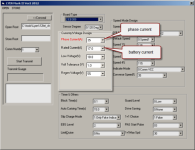2 part question:
1) I bought 60 pcs 2500mah Samsung 25R 18650 cells and put them into a 12s5p config.
I am told a safe continuous max is about 3c
So let me know if this math is correct:
To get 35a max draw on batts (what the motor seems to safely be able to handle - it's a small brushless gearless hub motor 10" tire)
2.5ah x 5p = 12.5ah x 2.8c = 35a
So I'm just under 3c at 35a pull correct?
2) The only issue I seem to have when I push the motor to 40a for more than a few seconds (like a 30 second+ ride up a steep hill) is that the three phase wires start to melt through the insulation because they heat up so much, primarily within the 6-10" closest to where they exit the hub motor and they touch and short of course which effectively grinds the motor to a halt and it makes noises if you try to accelerate. They are not permanently fused at the metal, just touching because of the melted insulation, so when I separate them and re-cover with fresh insulation/heat shrink/electrical tape the motor is good to go again. I am wondering if the gauge of the wire (which looks like 14 or even maybe higher, kinda thin) were to be enlarged at the hub or the wires were shortened to the controller (they are about 15" long from motor to controller currently) or a thicker/stronger insulation were used if the motor could handle the higher amperage for a period of time? (Controller is good for up to 72v and 50a) Other than that the controller, throttle, wiring, batts all seem fine and the motor just gets a little hot to the touch but again only after a long sustained hill ride...
Help - thx!
1) I bought 60 pcs 2500mah Samsung 25R 18650 cells and put them into a 12s5p config.
I am told a safe continuous max is about 3c
So let me know if this math is correct:
To get 35a max draw on batts (what the motor seems to safely be able to handle - it's a small brushless gearless hub motor 10" tire)
2.5ah x 5p = 12.5ah x 2.8c = 35a
So I'm just under 3c at 35a pull correct?
2) The only issue I seem to have when I push the motor to 40a for more than a few seconds (like a 30 second+ ride up a steep hill) is that the three phase wires start to melt through the insulation because they heat up so much, primarily within the 6-10" closest to where they exit the hub motor and they touch and short of course which effectively grinds the motor to a halt and it makes noises if you try to accelerate. They are not permanently fused at the metal, just touching because of the melted insulation, so when I separate them and re-cover with fresh insulation/heat shrink/electrical tape the motor is good to go again. I am wondering if the gauge of the wire (which looks like 14 or even maybe higher, kinda thin) were to be enlarged at the hub or the wires were shortened to the controller (they are about 15" long from motor to controller currently) or a thicker/stronger insulation were used if the motor could handle the higher amperage for a period of time? (Controller is good for up to 72v and 50a) Other than that the controller, throttle, wiring, batts all seem fine and the motor just gets a little hot to the touch but again only after a long sustained hill ride...
Help - thx!


